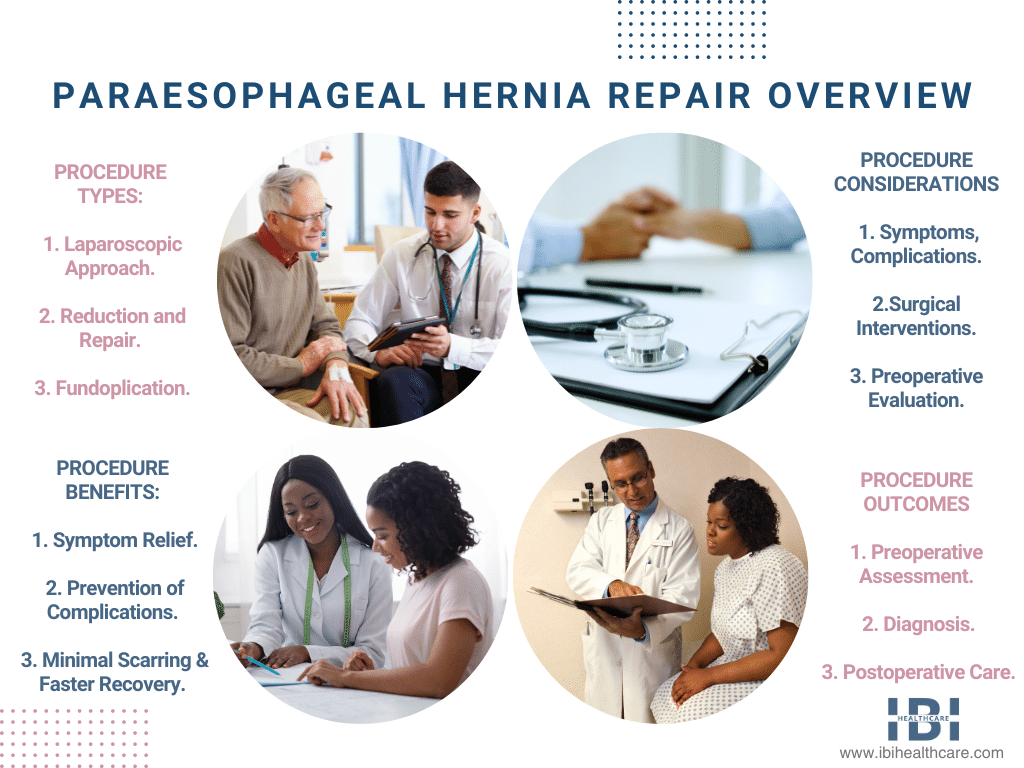Paraesophageal Hernia Repair Procedure Overview
A paraesophageal hernia also known as a hiatal hernia. Furthermore, occurs when the upper part of the stomach protrudes into the chest cavity. In reality, through the hiatus, an opening in the diaphragm. Moreover, surgical repair of a paraesophageal hernia involves correcting this abnormality to prevent complications and alleviate symptoms. Similarly, the procedure repositions the stomach and the hiatus, the opening in the diaphragm. Further tightened it to prevent further herniation.
Paraesophageal Hernia Recovery Time
As a matter of fact, recovery time after paraesophageal hernia repair varies. Depending on the individual’s overall health, the extent of the hernia, and the surgical approach used. Generally, patients can expect to return to normal activities within 6 to 8 weeks following the procedure.
Paraesophageal Hernia Associated Risks
While surgeons generally consider paraesophageal hernia repair safe. However, it may include infection, anesthesia complications, damage to surrounding organs, and recurrence of the hernia.
Who is the Right Candidate for the Paraesophageal Hernia?
In particular, individuals who have been experiencing symptoms. For example, difficulty swallowing, chest pain, or reflux. Additionally, candidates should be in overall good health and able to tolerate surgery under anesthesia. Nevertheless, candidates need to undergo a thorough evaluation. In the final analysis to determine if they are suitable candidates for the procedure.

Paraesophageal Hernia Procedure Types
1. Laparoscopic Approach
During laparoscopic surgery, the surgeon makes small incisions in the abdomen. Then, the surgeon inserts a laparoscope to visualize the hernia and surrounding structures.
2. Reduction and Repair
Besides this, the surgeon carefully reduces the herniated stomach back into the abdominal cavity. Similarly, repairs the defect in the diaphragm using sutures or a synthetic mesh.
3. Fundoplication
The surgeon may perform a fundoplication procedure in addition to hernia repair. Eventually, reinforces the lower esophageal sphincter and reduces reflux symptoms.
Paraesophageal Hernia Important Considerations
1. Symptoms and Diagnosis
Surely, paraesophageal hernia symptoms may include heartburn, chest pain, difficulty swallowing, and regurgitation. Diagnosis typically involves imaging tests such as barium swallow or upper endoscopy.
2. Complications
However, if left untreated, a paraesophageal hernia can lead to complications. Such as gastric volvulus – twisting of the stomach, esophageal stricture – narrowing of the esophagus, and gastrointestinal bleeding. Besides this, anesthesia complications, damage to surrounding organs, and recurrence of the hernia may occur.
3. Surgical Indications and Interventions
Indeed, surgeons recommend surgical intervention for symptomatic paraesophageal hernias. Large hernias that are at risk of complications, or hernias that cause significant reflux despite medical treatments.
4. Preoperative Evaluation
Before surgery, patients undergo a comprehensive preoperative evaluation. To assess their overall health and identify any underlying medical conditions that may affect the surgical outcome.
Paraesophageal Hernia Benefits
1. Symptom Relief
Indeed, surgical repair can alleviate symptoms. For instance heartburn, chest pain, and difficulty swallowing, improving the patient’s quality of life.
2. Prevention of Complications
In reality, by correcting the anatomical abnormality and reducing the risk of gastric volvulus and other complications. Nonetheless, the surgery helps prevent serious medical emergencies.
3. Long-Term Success
Although, studies have shown that laparoscopic paraesophageal hernia repair has excellent long-term outcomes. Evidently, with low rates of recurrence and high patient satisfaction.
4. Minimal Scarring and Faster Recovery
Unquestionably, the procedure results in smaller incisions. In addition to this, less postoperative pain, and faster recovery compared to traditional open surgery.
In any event, experiencing symptoms of a hernia or paraesophageal hernia. Nonetheless, call us or schedule a consultation to discuss your specific case.










